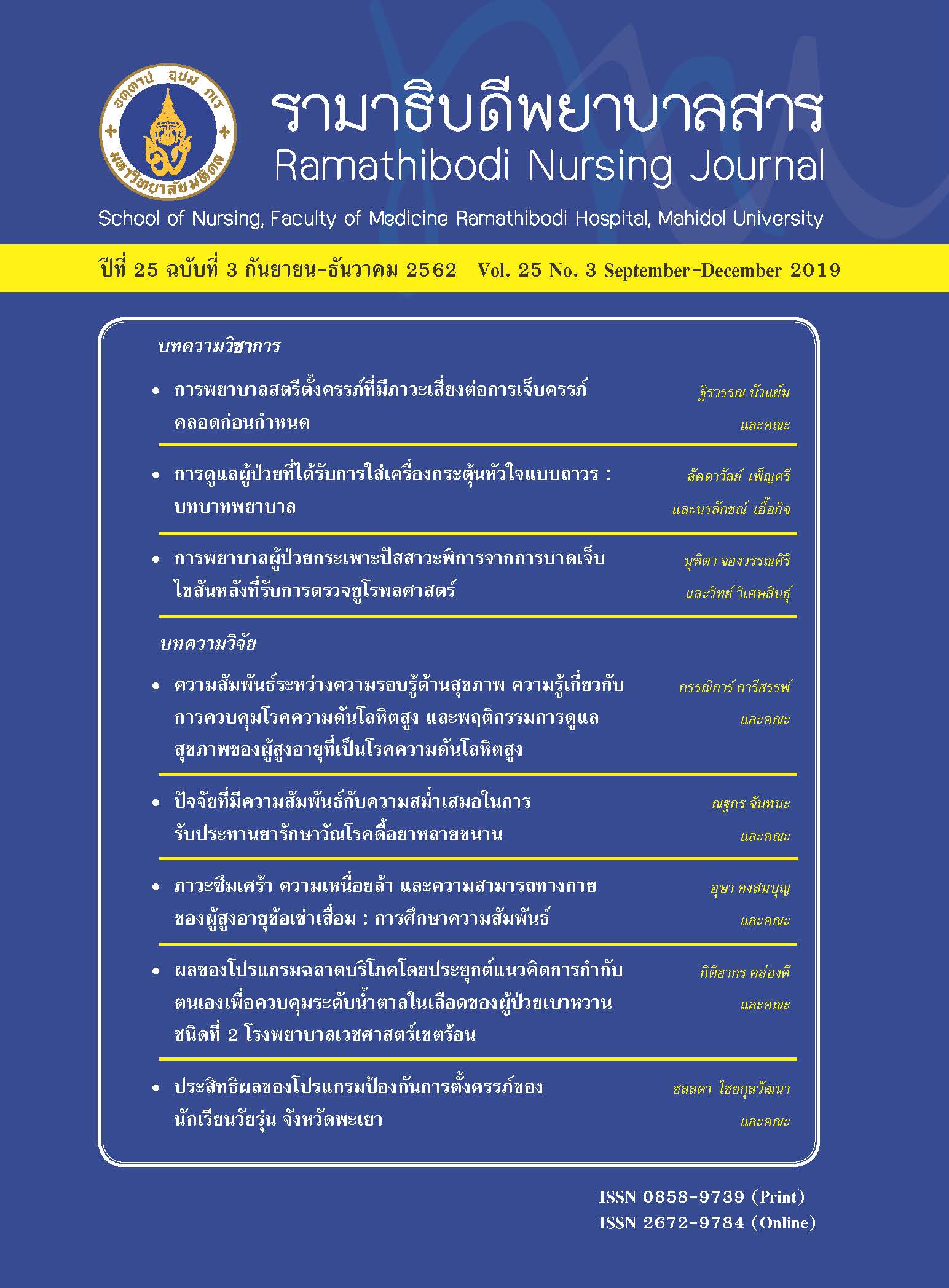Nursing care: Patient with Neurogenic Lower Urinary Tract Dysfunction from Spinal Cord Injury for Urodynamic Study
Main Article Content
Abstract
Patients with neurogenic lower urinary tract dysfunction from spinal cord injury need proper treatment, follow up and care for life to prevent complications including deterioration of renal function, urinary tract infection, loss of bladder compliance and high storage bladder pressure. Urodynamic study is to evaluate the status of the lower urinary tract dysfunction and follow up bladder pressure to guide the treatment. This study might cause anxiety in patients and families because it is not a common procedure and there are some complications from the test. Therefore, Urodynamic Nurses should be aware of these problems and provide nursing care for both physical and mental health in order to decrease anxiety, prevent complications of urodynamic study and achieved effective procedure. This article reviews the basic knowledge of neurogenic lower urinary tract dysfunction and complications, physiology of urination, urodynamic study and nursing role in caring these patients.
Article Details
บทความ ข้อมูล เนื้อหา รูปภาพ ฯลฯ ที่ได้รับการตีพิมพ์ในรามาธิบดีพยาบาลสาร ถือเป็นลิขสิทธิ์ของวารสาร หากบุคคลหรือหน่วยงานใดต้องการนำทั้งหมดหรือส่วนหนึ่งส่วนใดไปเผยแพร่หรือเพื่อกระทำการใด ใด จะต้องได้รับอนุญาตเป็นลายลักษณ์อักษรจากรามาธิบดีพยาบาลสารก่อนเท่านั้น
References
from: https://www.nscisc.uab.edu
2. Taweel WA, Seyam R. Neurogenic bladder in spinal cord injury patients. Res Rep Urol. 2015;7:85-99.
3. Sanjay Sinha. Follow-up urodynamics in patients with neurogenic bladder. Indian J Urol. 2017;33(4):267-75.
4. Yiou R, Audureau E, Loche CM. Comprehensive evaluation of embarrassment associated with invasive urodynamics. Neurourol Uodyn. 2015;34:156-60.
5. Shaw C, Williams K, Assassa PR, Jackson C. Patient satisfaction with urodynamics: aqualitative study. J Adv
Nurs. 2000;32(6):1356-63.
6. Fonte N. Urological care of the spinal cord injured patient. JWOCN. 2008;35(3):323-31.
7. Stav K, Siegel YI, Beberashaili I, Sella HZ, Zisman A. Provision of information leaflet before urodynamic study
reduces the pre-examination anxiety level. Neurourol Urodyn. 2016;35(7):805-8.
8. Permpech R, Butsripoom B. The role of perioperative nurse: health education for pre and postoperative visiting.
Ramathibodi Nursing Journal [Internet] [cited 31Jul.2019];22(1):9-20.
9. Tantanuch M. Anatomy and Physiology of The Lower Urinary Tract System. In: Mahawong P, Viseshsindh W,
SantiNgamkun A, editors. Basic Urodynamics and Clinical Applications. Bangkok: Idea Instant Printing; 2019.p.11-22.
10. Jitjang W. Pathophysiology of neurogenic bladder and classification. In: Kochakarn W,editors. Textbook of
Neurogenic Bladder. Bangkok: Beyond Enterprise; 2009. p.7-13.
11. Jahromi MS, Mure A, Gomez CS. UTIs in patients with neurogenic bladder. Curr Urol Rep. 2014;15(9):433.
12. Roop S, Rajesh K, Kapil S, Ramchander S, Narender K. Bladder manangement methods and urological complications in spinal cord injury patients. Indian J Orthop. 2011;45(2):141-7.
13. David P. Tumor of the bladder. In: Wein AJ, Kavoussi LR, Partin AW, Peters CA, editors. Campbell’s Urology
11th ed. Philadelphia: Elsevier; 2016. p.2185-2201.
14. Canon S, Shera A, Phan NM, Lapicz L, Scheidweiler T, Batchelor, et al. Autonomic dysreflexia during urodynamics
in children and adolescents with spinal cord injury or severe neurologic disease. J Pediatr.Urol. 2015;11(1):32.
15. Dolonak D, Balraj E. Autonomic dysreflexia and sudden death in people with traumatic spinal cord injury. Am J
Forensic Med Pathol. 2007;28(2):95-8.
16. Victor W Nitti. Urodynamic and video urodynamic evaluation of the lower urinary tract. In: Wein AJ, Kavoussi
LR, Partin AW, Peters CA, editors. Campbell’s Urology 11th ed. Philadelphia: Elsevier; 2016. p.1719-42.
17. Santingamkun A. Urodynamics in patients with spinal cord diseases. In: Mahawong P, Viseshsindh W, SantiNgamkun
A, editors. Basic Urodynamics and Clinical Applications. Bangkok: Idea Instant printing; 2019. p.227-42.
18. Rosier PFWM, Schaefer W, Lose G, Goldman HB, Guralnick M, Eustice S, et al. International continence
society good urodynamic practice and terms 2016: urodynamic, uroflowmetry, cystometry, and pressure-flow
study. Neurourol Urodyn. 2017;36(5):1243-60.
19. Xavier B, Ornella L, Van B, Lysanne C, Jacques C. Prospective evaluation of anxiety, pain, and embarrassment
associated with cystoscopy and urodynamic testing in clinical practice. Can Urol Assoc J. 2017;11(3-4):104-
10.
20. Tulloch I, Rubin JS. Assessment and management of preoperative anxiety. J Voice. 2018.
21. Drake MJ. Management and rehabilitation of neurologic patients with lower urinary tract dysfunction. Handb Clin
Neurol. 2015;130:451-68.
22. Kalogianni A, Almpani P, Vastardis L, Baltopoulos G, Charitos C. Can nurse-led preoperative education reduce
anxiety and postoperative complications of patients undergoing cardiac surgery?. Eur J Cardiovasc Nurs.
2016;15(6):447-58.
23. Stav K, Siegel YI, Beberashaili I, Sella HZ, Zisman A. Provision of information leaflet before urodynamic study
reduces the pre-examination anxiety level. Neurourol Urodyn. 2016;35(7):805-8.
24. Warda H, Hacker MR, Haviland MJ, Hota LS. A telephone call to decrease patient anxiety before urodynamic testing:
a randomized controlled trial. Female Pelvic Med Reconstr Surg. 2018;25(5):378-82.
25. Ozturk E, Yikilmaz TN, Basar H, Hamidi N, Ozcan C. Effect of listening to music on patient anxiety and pain
perception during urodynamic study: randomized controlled trial. Low Urin Tract Symptoms.2019;11(1):39-42.
26. Virseda M, Salinas J, Gutierrez P, Marta M, Lopez A. Risk factors to develop autonomic dysreflexia during
urodynamic examinations in patients with spinal cord injury. Neurourol Urodyn. 2017;36(1):171-5.
27. Rahardjo HE, Tirtayasa PM, Afriansyah A, Parikesit D, Akbar MI. The Effectiveness of a three day course
antibiotic Post - urodynamic study in preventing lower urinary tract infection. Acta Med Indones. 2016;48(2):84-90.


